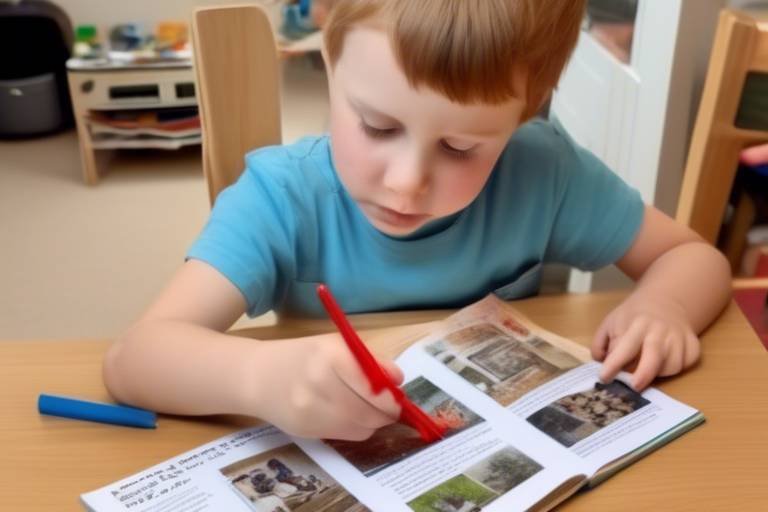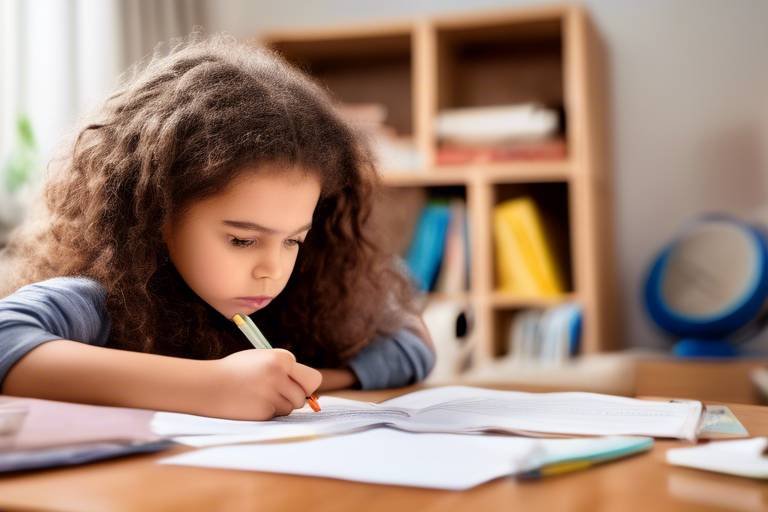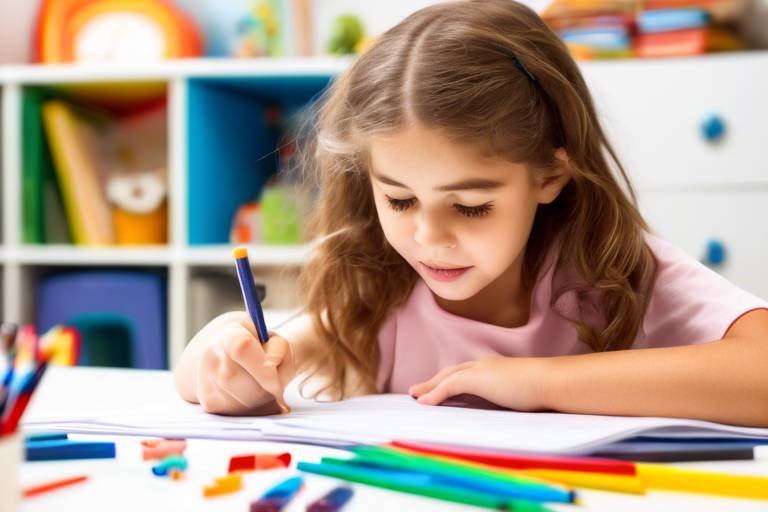Advancing Kids' Critical Thinking through Home Education
In today's rapidly changing world, the ability to think critically is more important than ever. As parents, we often wonder how we can best prepare our children for the challenges that lie ahead. Home education provides a unique opportunity to not only educate our kids academically but also to nurture their critical thinking skills. But what does that really mean? How can we, as parents, effectively foster analytical and independent thought in our children? This article explores these questions, offering insights and strategies that will empower you to enhance your child's critical thinking abilities through home education.
Critical thinking is not just a buzzword; it’s a fundamental skill that shapes how children perceive the world around them. Think about it: every day, our kids are bombarded with information from various sources—social media, news outlets, and even their peers. Without the ability to critically evaluate this information, they may struggle to make informed decisions. This skill is vital for their future, influencing everything from academic success to personal relationships and career choices. By teaching our children to think critically, we equip them with the tools to navigate complex situations, solve problems creatively, and understand different perspectives. In essence, critical thinking is like a compass, guiding them through the maze of life.
Home education offers a unique platform for cultivating critical thinking skills. Unlike traditional classrooms, where the pace may be dictated by a standardized curriculum, home education allows children to explore subjects that genuinely interest them. This freedom fosters a sense of curiosity and inquiry, encouraging them to ask questions and seek answers. Imagine your child diving deep into a topic of interest—whether it’s space exploration or ancient civilizations—engaging in discussions that challenge their viewpoints and expand their understanding. This personalized approach not only makes learning more enjoyable but also helps develop a robust analytical mindset.
Establishing a conducive learning atmosphere at home is crucial for fostering critical thinking. Parents can create spaces that inspire curiosity and creativity. For instance, consider setting up a cozy reading nook filled with books on various subjects, or a science corner equipped with materials for experiments. The environment should be inviting and stimulating, encouraging children to explore and discover. Remember, learning doesn’t have to happen at a desk; it can take place on a nature walk, in the kitchen while cooking, or even during family discussions around the dinner table. The key is to make learning an integral part of daily life.
One of the most effective ways to promote critical thinking is through hands-on activities. These experiences allow children to apply what they’ve learned in real-world scenarios. For example, conducting science experiments at home not only makes learning fun but also encourages children to hypothesize, test, and draw conclusions based on their observations. Projects like building a model volcano or creating a simple circuit can ignite their passion for learning while honing their analytical skills. Such activities transform abstract concepts into tangible experiences, making it easier for children to retain and understand complex ideas.
Fostering open discussions about various topics is another powerful strategy for enhancing critical thinking. Encourage your children to express their thoughts and opinions on current events, books they’ve read, or even family decisions. By doing so, you challenge them to articulate their reasoning and consider different perspectives. Ask open-ended questions that require more than a yes or no answer, such as, “What do you think about this situation?” or “Why do you believe that?” This practice not only promotes critical thinking but also strengthens communication skills, preparing them for future interactions in both personal and professional settings.
Leveraging various educational resources can significantly enrich the learning experience. With the vast array of materials available today—books, online courses, documentaries—parents have the opportunity to select resources that align with their children’s interests and stimulate critical thinking. For example, watching a documentary on climate change can spark discussions about environmental responsibility, while an online course in coding can encourage logical reasoning and problem-solving skills. The key is to choose resources that not only educate but also inspire curiosity and a desire to learn more.
Evaluating your child’s critical thinking abilities is essential for identifying strengths and areas for improvement. Regular assessment allows you to track progress and adjust your teaching strategies accordingly. But how can you effectively assess their critical thinking skills?
One effective method is through observation. Pay attention to how your child interacts during discussions and activities. Are they able to analyze information, draw conclusions, and articulate their thoughts clearly? Observing these interactions can provide valuable insights into their critical thinking processes. You might even consider keeping a journal to document their progress over time, noting instances where they demonstrate strong analytical skills or where they may need additional support.
Providing constructive feedback is another crucial aspect of developing critical thinking. After discussions or activities, take the time to reflect with your child on what they learned. Encourage them to think about their thought processes and how they arrived at their conclusions. This practice not only fosters a growth mindset but also motivates them to improve their critical thinking skills further. Remember, the goal isn’t just to provide answers but to guide them in discovering the answers for themselves.
- What age is appropriate to start fostering critical thinking skills? It’s never too early! Even young children can benefit from activities that promote curiosity and inquiry.
- How can I incorporate critical thinking into everyday activities? Use daily situations, like grocery shopping or cooking, as opportunities to discuss choices and consequences.
- Are there specific resources you recommend for home education? Look for interactive books, online courses, and educational games that align with your child's interests.

The Importance of Critical Thinking
Critical thinking is not just a buzzword; it’s a vital skill that shapes how children perceive and interact with the world around them. Imagine your child as a detective, piecing together clues to solve puzzles in their everyday life. This ability to analyze, evaluate, and synthesize information is crucial for making informed decisions and navigating challenges. In a world overflowing with information, teaching kids to think critically equips them with the tools to discern fact from fiction and to approach problems with a logical mindset.
Why is critical thinking so essential in today's fast-paced environment? Well, consider this: children who develop strong critical thinking skills are better prepared to tackle real-world problems. They learn to ask the right questions, seek out reliable sources, and evaluate evidence before forming conclusions. This skill set not only enhances their academic performance but also prepares them for future careers where innovation and problem-solving are key.
Moreover, critical thinking fosters independence and confidence. When children learn to think for themselves, they become more self-reliant and capable of making decisions without constant guidance. They start to understand that it’s okay to challenge ideas and that their opinions matter. This empowerment can lead to greater engagement in their learning processes and a deeper understanding of complex subjects.
To illustrate the importance of critical thinking, let’s break it down into a few key benefits:
- Enhanced Problem-Solving Skills: Critical thinkers can approach challenges methodically, breaking them down into manageable parts and exploring various solutions.
- Better Communication: As children articulate their thoughts and reasoning, they become more effective communicators, able to express their ideas clearly and persuasively.
- Informed Decision-Making: With critical thinking, children can weigh pros and cons, consider potential consequences, and make choices that are in their best interest.
In conclusion, fostering critical thinking in children is not just about academic success; it’s about preparing them for life. When parents prioritize this skill, they’re investing in their children’s future, helping them become thoughtful, informed, and engaged individuals. So, how can we cultivate this essential skill at home? Let’s explore the unique opportunities that home education offers.

Home Education as a Platform
Home education is not just a trend; it’s a transformative approach to learning that empowers children to think critically and independently. Unlike traditional classroom settings, home education provides a unique environment where children can explore their interests and develop their analytical skills at their own pace. Imagine a place where curiosity is nurtured, questions are encouraged, and the world is a classroom. This is what home education offers, and it’s a powerful platform for fostering critical thinking.
One of the most significant advantages of home education is the flexibility it provides. Parents can tailor the curriculum to fit their child's learning style and interests. This personalized approach means that children can delve deeper into subjects that fascinate them, rather than being confined to a one-size-fits-all curriculum. For instance, if a child shows a keen interest in science, parents can incorporate hands-on experiments and real-world applications that ignite their passion. This not only makes learning enjoyable but also enhances their ability to think critically about complex concepts.
Moreover, home education allows for a more interactive learning experience. Children can engage in discussions that challenge their perspectives and encourage them to think outside the box. This interaction can take many forms, such as family debates on current events, collaborative projects, or even discussions about books they’ve read. By encouraging children to articulate their thoughts and defend their opinions, parents are effectively honing their critical thinking skills. After all, what better way to develop analytical abilities than by engaging in lively discussions that require reasoning and evidence?
Another essential aspect of home education is the opportunity for real-world learning. Parents can take education beyond textbooks and into the community. Field trips, volunteer opportunities, and hands-on projects in local environments can provide practical experiences that deepen understanding and stimulate critical thinking. For example, visiting a science museum can spark a child’s interest in biology or physics, leading to discussions about the exhibits and their implications. This experiential learning is invaluable, as it allows children to apply their knowledge and think critically about the world around them.
To create a truly enriching home education environment, parents should also consider the physical space where learning occurs. Designating a specific area for study that is free from distractions can help children focus and feel more engaged. This space should be filled with resources that inspire curiosity, such as books, art supplies, and educational games. By creating an inviting and stimulating environment, parents can encourage their children to explore and inquire, laying the groundwork for critical thinking.
In summary, home education serves as a robust platform for developing critical thinking skills. By fostering a personalized learning environment, encouraging interactive discussions, providing real-world experiences, and creating a conducive learning space, parents can significantly enhance their children's ability to think critically and independently. This approach not only prepares them for academic success but also equips them with the skills they need to navigate the complexities of life.
- What are the benefits of home education for critical thinking?
Home education allows for personalized learning, interactive discussions, and real-world experiences, all of which contribute to enhanced critical thinking skills. - How can I create a conducive learning environment at home?
Designate a specific study area, fill it with inspiring resources, and ensure it is free from distractions to foster a productive learning atmosphere. - What types of activities promote critical thinking in children?
Hands-on experiments, group discussions, and field trips can all encourage children to think critically and engage with their learning.

Creating a Learning Environment
Establishing a conducive learning atmosphere at home is crucial for nurturing a child's critical thinking skills. Think of your home as a canvas where every corner can be turned into a vibrant learning space. The goal is to create an environment that not only encourages curiosity but also fosters creativity. This means setting up areas that are not just functional, but also inspiring. For instance, a cozy reading nook filled with books can ignite a passion for learning, while a science corner equipped with materials for experiments can stimulate inquiry and exploration.
It's essential to make the learning environment dynamic and adaptable. Children thrive when they can engage with their surroundings. Consider incorporating various elements that can stimulate their senses and encourage interaction. Here are a few ideas:
- Interactive Spaces: Create zones dedicated to different subjects, such as a math station with puzzles and games or an art corner with supplies for creative projects.
- Natural Elements: Bringing in plants or nature-inspired decor can enhance the atmosphere, making learning feel more connected to the world around them.
- Technology Integration: Utilize educational apps and online resources that promote critical thinking. A well-placed tablet or computer can serve as a gateway to a world of knowledge.
Moreover, the ambiance plays a significant role in how children perceive learning. Soft lighting, comfortable seating, and minimal distractions can transform a space into a haven for exploration. Imagine how much easier it is to think deeply when you’re surrounded by comfort and inspiration! To take it a step further, consider involving your children in the process of creating their learning space. Allowing them to choose colors, decorations, and even the arrangement of their study area can empower them and make them feel more invested in their education.
In addition to the physical space, fostering a positive mindset about learning is equally important. Encourage a culture of curiosity where questions are welcomed, and mistakes are seen as opportunities for growth. This can be achieved by regularly engaging in discussions about various topics, embracing a variety of viewpoints, and showing enthusiasm for new ideas. When children see their parents actively participating in learning, they are more likely to adopt the same attitude.
Ultimately, the learning environment should be a reflection of your family's values and interests. By cultivating a space that is rich in resources and supportive of exploration, you are setting the stage for your children to develop critical thinking skills that will serve them throughout their lives. Remember, it's not just about what they learn, but how they learn it. Creating a nurturing and stimulating environment is the first step in unlocking your child's potential.

Incorporating Hands-On Activities
When it comes to enhancing critical thinking skills in children, hands-on activities are like magic potions that can transform mundane learning into thrilling adventures. Imagine your child not just reading about the laws of physics but actually building a simple catapult to see those laws in action. This kind of active engagement helps children grasp complex concepts in a way that mere textbooks cannot. By allowing kids to explore, experiment, and create, we open up a world where they can ask questions like, “What happens if I change this variable?” or “How can I improve my design?”
These activities can range from science experiments to arts and crafts, each designed to stimulate curiosity and promote critical thinking. For instance, in a science project, your child could conduct an experiment to grow plants under different light conditions. This not only teaches them about photosynthesis but also encourages them to analyze the results, draw conclusions, and think critically about what they observe.
Moreover, incorporating hands-on activities can be as simple as cooking a meal together. When children follow a recipe, they learn about measurements and sequencing, and they also get to experiment with flavors—leading to a discussion about taste preferences and nutritional values. It's not just about the end product; it’s about the process of thinking critically through each step.
To further enhance the learning experience, consider using a variety of resources and tools. For example, you might set up a small science lab at home with basic supplies, or use online platforms that offer interactive simulations. This variety ensures that children remain engaged and are exposed to different ways of thinking and problem-solving.
In essence, hands-on activities are not merely tasks; they are opportunities for children to immerse themselves in learning, to make connections, and to develop a mindset that values inquiry and exploration. The more they engage with the world around them, the more equipped they'll be to tackle challenges in the future. So, roll up your sleeves, get messy, and watch your child’s critical thinking skills flourish!
- What types of hands-on activities are best for critical thinking?
Activities that involve experimentation, problem-solving, and creativity, such as science experiments, building projects, and cooking, are excellent for promoting critical thinking. - How can I assess my child's critical thinking during these activities?
Observe how they approach problems, ask questions, and reflect on their outcomes. Discussing their thought processes can provide valuable insights. - Are there specific resources you recommend for hands-on learning?
Look for educational kits, online courses, and interactive websites that provide guided projects and experiments tailored to your child's interests.

Encouraging Open Dialogue
Encouraging open dialogue in a home education setting is like planting seeds in a garden; with the right care and attention, those seeds can blossom into vibrant discussions that enhance critical thinking. When children feel comfortable sharing their thoughts, they engage in a deeper exploration of ideas, which is essential for developing their analytical skills. It's not just about talking; it’s about fostering an environment where questions are welcomed, and curiosity is celebrated. This kind of atmosphere allows kids to express their opinions freely, which is crucial for their growth as independent thinkers.
One effective approach to promote open dialogue is to create a safe space where children know their ideas will be respected. This can be achieved by actively listening to their thoughts without immediately jumping to conclusions or dismissing them. Instead, parents can respond with questions that encourage further reflection. For example, if a child expresses a view on a particular subject, a parent might ask, “What led you to that conclusion?” or “Can you think of another perspective?” Such questions not only validate the child's opinion but also challenge them to think more critically about their reasoning.
Additionally, introducing current events or thought-provoking topics can serve as excellent conversation starters. Discussing news stories, scientific discoveries, or even ethical dilemmas can ignite passionate debates. Parents can ask their children what they think about certain issues, encouraging them to articulate their viewpoints and consider different angles. This practice not only sharpens their critical thinking but also helps them understand the complexity of real-world issues.
To further enrich these discussions, parents might also consider incorporating a variety of resources, such as books, documentaries, or podcasts, that present different viewpoints. This exposure helps children learn to appreciate diversity in thought and enhances their ability to engage in constructive dialogue. It's important to remind them that differing opinions are not only acceptable but can lead to richer conversations.
Finally, it’s essential to model the behavior you want to see. When parents demonstrate open-mindedness and curiosity in their conversations, children are more likely to mirror that behavior. By showing enthusiasm for learning and discussing new ideas, parents can inspire their children to become active participants in their own educational journeys.
- How can I encourage my child to express their thoughts more openly?
Start by creating a safe and supportive environment, where their opinions are valued. Ask open-ended questions and show genuine interest in their responses. - What topics are best for initiating discussions?
Current events, ethical dilemmas, and personal experiences are great starting points. Choose subjects that resonate with your child's interests. - How can I help my child understand different perspectives?
Encourage them to read diverse materials and discuss varying viewpoints. This can help them appreciate complexity and nuance in different issues.

Utilizing Educational Resources
In today's digital age, the array of educational resources available to parents and children is nothing short of astounding. From interactive online platforms to engaging documentaries, these resources can significantly enhance your child's learning experience. By tapping into a variety of materials, you can create a rich tapestry of knowledge that not only captivates your child’s attention but also nurtures their critical thinking skills.
One of the most effective strategies is to leverage online courses tailored to your child's interests. Websites like Khan Academy and Coursera offer a plethora of courses across various subjects. These platforms not only provide structured learning but also allow children to progress at their own pace. Imagine your child diving deep into a subject like astronomy or coding, driven by their curiosity and passion. This self-directed learning fosters independence and encourages them to ask questions, analyze information, and seek answers.
Additionally, don't overlook the power of documentaries and educational videos. Platforms like Netflix and YouTube have a treasure trove of content that can spark curiosity and ignite discussions. For instance, a documentary on climate change can lead to a family discussion about environmental responsibility, prompting your child to think critically about their role in the world. By watching these programs together, you can pause and engage in conversations that challenge their perspectives and encourage them to articulate their thoughts.
Books, both fiction and non-fiction, remain timeless educational resources. They can transport children to different worlds, introduce them to new ideas, and challenge their thinking. Consider creating a family reading list that includes a mix of genres. You might include:
- Fiction: Stories that challenge moral dilemmas or present complex characters.
- Non-fiction: Books that explore scientific concepts, historical events, or biographies of influential figures.
Moreover, incorporating hands-on resources, such as science kits or art supplies, can make learning more tangible. These materials allow children to experiment and create, which in turn cultivates their ability to think critically about the outcomes of their actions. For example, conducting a simple chemistry experiment can lead to questions about reactions and results, encouraging deeper inquiry.
Lastly, don't forget about the importance of community resources. Libraries, museums, and local workshops often offer programs that promote critical thinking through interactive learning experiences. Engaging with these resources can provide your child with diverse perspectives and new ideas, enriching their educational journey.
In summary, utilizing a variety of educational resources not only makes learning more enjoyable but also equips children with the tools they need to develop their critical thinking skills. By curating a mix of online courses, documentaries, books, hands-on activities, and community offerings, you can create a vibrant learning environment that encourages exploration and independent thought.
Q: How can I find suitable educational resources for my child?
A: Start by exploring reputable educational websites, local libraries, and community centers. You can also ask for recommendations from other homeschooling parents or educational forums.
Q: Are online courses effective for critical thinking development?
A: Yes! Online courses often encourage self-directed learning, allowing children to explore topics deeply and critically.
Q: How do documentaries promote critical thinking?
A: Documentaries present real-world issues and diverse perspectives, prompting discussions that challenge children to think critically about the content.
Q: What role do hands-on activities play in learning?
A: Hands-on activities engage children in active learning, allowing them to apply concepts in real-world scenarios, which enhances understanding and retention.

Assessment of Critical Thinking Skills
Evaluating children's critical thinking abilities is essential for identifying their strengths and areas for improvement. Just like a gardener nurtures plants, parents must cultivate their children's thinking skills to help them flourish. By regularly assessing these skills, parents can tailor their teaching strategies to better suit their child's unique learning style. This process not only enhances the child's analytical capabilities but also boosts their confidence in making decisions and solving problems.
There are various methods to assess critical thinking skills effectively. One approach is through observation. By watching how children engage in discussions and tackle problems, parents can gain insights into their thought processes. For example, when a child is faced with a question, do they jump to conclusions, or do they take time to analyze the information before responding? Such observations can reveal much about their critical thinking abilities.
Another effective method is through feedback and reflection. Providing constructive feedback after discussions or activities encourages children to think about their reasoning. For instance, when a child shares their opinion on a topic, parents can ask questions like, "What led you to that conclusion?" or "Can you think of another perspective?" This not only promotes deeper thinking but also instills a habit of self-reflection, which is crucial for developing critical thinking skills.
Additionally, parents can utilize various assessment tools to monitor progress. These might include quizzes, open-ended questions, or even creative projects that require critical analysis. For instance, a simple table can help track the skills being assessed:
| Assessment Method | Description | Frequency |
|---|---|---|
| Observation | Watch how children approach problems and discussions. | Weekly |
| Feedback Sessions | Discuss outcomes of activities and encourage self-reflection. | After each activity |
| Quizzes/Projects | Use creative assessments to gauge understanding. | Monthly |
By implementing these strategies, parents can create a comprehensive assessment plan that not only tracks their children's critical thinking skills but also fosters a love for learning. Remember, the goal is not just to evaluate but to inspire. When children see that their thoughts and opinions matter, they are more likely to engage deeply in their learning journey.
- What are the signs of strong critical thinking skills in children? Look for signs such as the ability to ask insightful questions, analyze information critically, and articulate their thoughts clearly.
- How can I encourage my child to think critically? Encourage open discussions, ask thought-provoking questions, and provide opportunities for hands-on learning experiences.
- Is there a specific age to start assessing critical thinking skills? It's beneficial to start as early as possible; even young children can be encouraged to think critically through play and simple discussions.

Observation Techniques
Observation is a powerful tool in the realm of home education, especially when it comes to evaluating your child's critical thinking skills. By carefully watching how your child interacts with their environment, engages in discussions, and tackles challenges, you can gain invaluable insights into their thought processes. This method is akin to being a detective, piecing together clues to understand how your child thinks and learns. But how exactly can you implement effective observation techniques?
First, consider creating a structured observation schedule. This doesn't mean you need to turn it into a formal event, but having a routine can help you focus on specific skills over time. For example, you might dedicate certain days to observe how your child approaches problem-solving in math or how they express their opinions during discussions about books or current events. This structured approach allows you to see growth and identify areas that may need more attention.
When observing, it's essential to take notes. Jot down your child's responses, the questions they ask, and their ability to articulate their thoughts. You can create a simple table like the one below to track their progress over time:
| Date | Activity | Observations | Critical Thinking Skills Demonstrated |
|---|---|---|---|
| 2023-10-01 | Science Experiment | Asked insightful questions about the results. | Analytical thinking, inquiry |
| 2023-10-05 | Book Discussion | Provided different perspectives on the characters' choices. | Reasoning, perspective-taking |
Additionally, create an environment that encourages open-ended questions. Instead of simply asking your child to recount facts, prompt them with questions that require deeper thinking. For instance, instead of asking, "What happened in the story?" you might ask, "Why do you think the character made that choice?" This approach not only stimulates critical thinking but also helps you observe how your child articulates their reasoning and develops their arguments.
Another effective technique is to observe your child's interactions with peers or family members. Group discussions can reveal how well they can listen, respond, and adapt their ideas based on others' input. Pay attention to their ability to debate respectfully and how they handle disagreements. These social interactions are crucial for developing critical thinking as they teach children to navigate different viewpoints and refine their own arguments.
In conclusion, observation techniques are an essential part of fostering critical thinking in home education. By being attentive and engaged, you can help your child develop their analytical skills while also creating a supportive learning environment. Remember, the goal is not just to assess but to inspire and guide your child towards becoming a confident thinker.
- How can I encourage my child to ask more questions?
Encourage curiosity by showing enthusiasm for their inquiries and providing them with resources to explore their interests further.
- What are some signs that my child is developing critical thinking skills?
Look for signs such as the ability to analyze different viewpoints, articulate their reasoning, and ask insightful questions.
- How can I make learning more engaging at home?
Incorporate hands-on activities, discussions, and real-world problem-solving scenarios to make learning both fun and impactful.

Feedback and Reflection
When it comes to nurturing critical thinking skills in children, feedback and reflection play pivotal roles. Think of feedback as the compass guiding your child through the vast ocean of knowledge. It helps them navigate through ideas, correcting their course when necessary and reinforcing the right path. Providing constructive feedback is not just about pointing out what they did wrong; it’s about highlighting what they did well and suggesting ways to improve. This dual approach fosters a growth mindset, encouraging children to see challenges as opportunities for learning rather than obstacles.
Reflection, on the other hand, is like a mirror that allows children to see their thought processes clearly. By taking the time to reflect on their learning experiences, children can analyze their reasoning, understand their mistakes, and celebrate their successes. You might ask them questions like, “What do you think worked well in your project?” or “How would you approach this problem differently next time?” Such questions invite them to dive deeper into their thought patterns, enhancing their ability to think critically.
To make the most of feedback and reflection, parents can create a structured environment where these practices are a regular part of the learning process. Here are some strategies to implement:
- Regular Check-ins: Schedule weekly or bi-weekly discussions to review what your child has learned and how they approached various tasks.
- Journaling: Encourage your child to keep a learning journal where they can jot down their thoughts, feelings, and reflections on their learning journey.
- Peer Feedback: If you have more than one child, promote an environment where they can give each other feedback on projects or ideas, fostering a collaborative learning atmosphere.
Additionally, consider using a simple table to track your child’s progress in critical thinking skills over time. This can help visualize their growth and areas that may need more focus:
| Date | Activity | Feedback Given | Child’s Reflection |
|---|---|---|---|
| 01/01/2023 | Science Experiment | Great hypothesis! Next time, try to predict the outcome more clearly. | I learned that my prediction was wrong, but it was fun to see the results! |
| 01/15/2023 | Book Report | Excellent analysis of the characters. Consider exploring the themes more. | I realized I could have connected the themes to real life better. |
By incorporating feedback and reflection into your home education strategy, you're not just helping your child improve academically; you're equipping them with the skills they need to navigate life’s complexities. Remember, the goal is to create a safe space where your child feels comfortable sharing their thoughts and where they can learn from both successes and failures. This practice not only enhances their critical thinking skills but also builds their confidence, making them more resilient learners.
- How can I provide effective feedback? Focus on being specific, timely, and constructive. Highlight strengths and offer suggestions for improvement.
- What are some reflection techniques for children? Encourage journaling, discussions, or even creative projects that allow them to express their thoughts on their learning experiences.
- How often should I assess my child's critical thinking skills? Regular assessments, such as weekly or monthly check-ins, can help track progress and adjust strategies as needed.
Frequently Asked Questions
- What is critical thinking and why is it important for children?
Critical thinking is the ability to analyze information, evaluate evidence, and make reasoned judgments. It’s essential for children because it equips them to tackle problems, make informed decisions, and navigate the complexities of life. Just like a compass helps you find your way, critical thinking guides children in their learning journey.
- How can home education foster critical thinking skills?
Home education allows for a personalized learning experience where children can explore subjects deeply and at their own pace. This environment encourages curiosity and inquiry, which are key ingredients for developing critical thinking skills. Think of it as having a custom-built playground for the mind!
- What types of hands-on activities can enhance critical thinking?
Hands-on activities like science experiments, art projects, and problem-solving games are fantastic for promoting active learning. These experiences not only make learning fun but also allow children to apply their critical thinking skills in real-world situations, helping them connect the dots between theory and practice.
- How can parents create a conducive learning environment at home?
To create a supportive learning space, parents can set up areas that are free from distractions and filled with resources that spark curiosity. Incorporating comfortable seating, engaging materials, and a routine that encourages exploration can transform any corner of the home into a vibrant learning hub.
- Why is open dialogue important in developing critical thinking?
Open dialogue encourages children to express their thoughts and challenge ideas. When they articulate their reasoning and consider different perspectives, it sharpens their analytical skills. It’s like a mental workout that strengthens their ability to think critically!
- What resources can parents use to support critical thinking?
Parents can utilize a variety of educational resources such as books, online courses, documentaries, and interactive apps. Selecting materials that align with their children's interests can make learning more engaging and effective, turning education into an exciting adventure.
- How can parents assess their child's critical thinking skills?
Assessing critical thinking can be done through observation of discussions, activities, and the way children approach problem-solving tasks. Parents can also use quizzes and reflective exercises to gauge understanding and encourage self-assessment, helping children recognize their strengths and areas for improvement.
- What role does feedback play in developing critical thinking?
Constructive feedback is crucial as it helps children understand their thought processes and guides them toward improvement. Encouraging self-reflection after tasks allows kids to learn from their experiences, fostering a growth mindset that is essential for enhancing critical thinking skills.



















